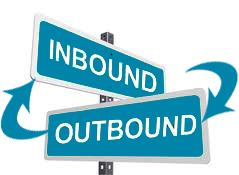The Rules of Inbound Marketing Rewritten for Outbound Marketers
 Sales Prospecting Perspectives is pleased to bring you a guest post from Lisa Fugere, Content Marketing Strategist at Radius Intelligence a company that offers sales prospecting software powered by big data. You can find her on Google +!
Sales Prospecting Perspectives is pleased to bring you a guest post from Lisa Fugere, Content Marketing Strategist at Radius Intelligence a company that offers sales prospecting software powered by big data. You can find her on Google +!
I cut my teeth in the B2B marketing world at a company that generates leads entirely through events and inbound marketing. With the naiveté of an English major who could recite every scene from Jane Eyre quicker than she could describe a lead list, I believed that inbound marketing was going to completely eclipse outbound marketing in a matter of years. Who would ever buy a list of leads when they could just wait for their customers to come to them? I thought.
Hundreds of thousands of companies, it turns out. The maintenance of an effective inbound marketing process requires an immense amount of work and resources, and for companies that sell to small businesses, a well-oiled inbound marketing funnel is simply not worth the effort and money. Companies like Aflac Insurance and Yellowpages.com–companies that sell to the millions of small businesses in the U.S.–aren’t going to fire their thousands-deep call centers to bring in an arsenal of copywriters to craft ebooks for small business owners to read in their vast amounts of spare time.
It’s been a long time since I first learned about the differences between inbound and outbound marketing for B2B organizations, and I’ve since discovered that some trends are universal–they just need a little rewording to appeal to different audiences. Inbound marketing is riding a huge wave through the marketing world, and some of its wisdom will redefine the way we think about marketing in general.
What can the champions of outbound marketing learn from the newly-elected content marketing king?
3 Rules of Inbound Marketing Rewritten for Outbound Marketers:
1. Segment leads into specific categories based on lead behavior to better customize marketing messages in nurture campaigns.
Inbound marketing operates on the assumption that leads entering the funnel are likely not ready to buy. Inbound marketers classify all leads by a set of scoring criteria designed to identify which leads are warm enough to warrant sales calls, and which need further nurturing from marketing. The more segmented the leads, the easier it is for the marketing team to send targeted messages that resonate with potential buyers. Marketing automation platforms can expose the details of prospects’ interactions with brands’ websites and content, and inbound marketers are getting better and better at classifying leads based on potential to buy.
The Rewritten Rule:
Segment leads into specific categories based on online behavior to better target businesses that are likely to buy.
Marketers are rethinking the way they qualify leads, and the traditional segmentation criteria that have become standard in the lead-buying lexicon (company size, industry, region) are no longer as indicative of likelihood to buy as socialgraphics, which include existence of a website, online review ratings, and social media activity. Outbound marketers don’t have the advantage of detailed insights about a prospect’s visit to their website that inbound marketers do, so they have to get more creative about the way they segment and target leads.
2. Share content on as many sources as possible.
To inbound marketers, more inquiries are always better; as long as leads are in the marketing automation system, marketers will know when challenges or opportunities morph them into target customers. Inbound marketers aim to generate buzz, and to do so they contribute others’ blogs, build engaged social media communities, host and promote contributed content, etc. All this activity pushes their brand in front of new eyes, and new eyes usually mean new sales opportunities.
The Rewritten Rule:
Score leads on the number of sources on which they’re listed.
Radius customers have discovered that the number of sources on which a business is listed has a positive correlation to marketing campaign response rates. The more sources on which you’ll find a business, the more likely that business is to respond to your marketing message. Rather than scoring leads based on their business size and location, try scoring them based on their online prevalence.
3. Create email seed lists.
An email seed list is a marketer’s test audience for new messages and products. Inbound marketers create seed lists to test out marketing campaigns before they unleash them on their entire databases.
The Rewritten Rule:
Create lead seed lists.
A lead seed list is a sample segment of leads in a marketing database. Before sending leads straight into the scoring machine and handing them off to sales, or before investing in a huge quantity of new leads, marketers can define unique sample segments and test them on their sales teams. A new Radius feature allows our customers to determine unique personas for their favorite customers, and the results are pretty consistently surprising. Our customers are learning trends that challenge what they thought they knew about their target audiences. Perhaps their sales have never performed well in the automotive industry not because those companies are poor fits, but rather because those companies are not socially-savvy enough to understand their services. Perhaps theirs sales perform so well in the restaurant industry because restaurants are more likely to have social media presence, and all their best customers have Facebook pages. A lead seed list can help marketers find new markets to scale their businesses.
Marketers have never had as much information about their customers available to them as they have today. The lead generation methods we praised a decade ago seem obsolete; the tides of marketing trends constantly shift. As we move into a new era of marketing–one led by social media and big data–outbound marketing is on the up and up. Since my days as an exclusive inbound marketer, I’ve learned that smart outbound prospecting is possible again–for the first time in years. Lead lists don’t have to be burdens anymore.

Lisa is a Content Marketing Strategist at Radius. In addition to managing and editing the blog, she is responsible for creating all Radius branded content, including ebooks, infographics, webinars, etc. Find her on Google+ or LinkedIn.
To learn more about identifying your market, acquiring accurate lead lists, and modern outbound lead generation tactics register for our next webinar with Radius and Heinz Marketing.